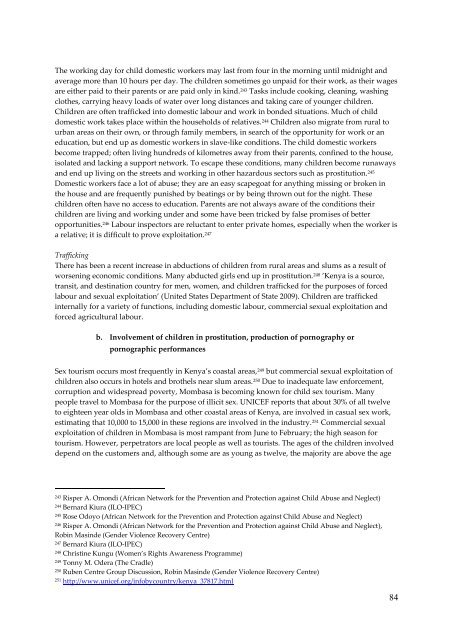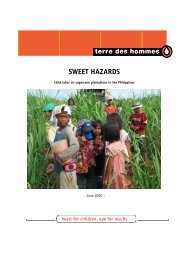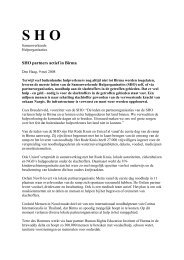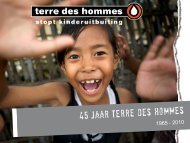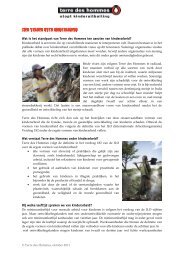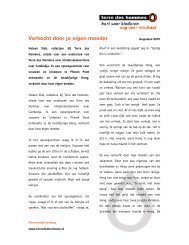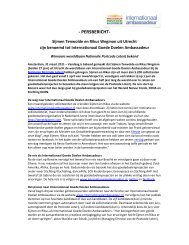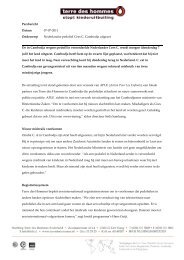Untitled - Terre des Hommes
Untitled - Terre des Hommes
Untitled - Terre des Hommes
- No tags were found...
You also want an ePaper? Increase the reach of your titles
YUMPU automatically turns print PDFs into web optimized ePapers that Google loves.
The working day for child domestic workers may last from four in the morning until midnight and<br />
average more than 10 hours per day. The children sometimes go unpaid for their work, as their wages<br />
are either paid to their parents or are paid only in kind. 243 Tasks include cooking, cleaning, washing<br />
clothes, carrying heavy loads of water over long distances and taking care of younger children.<br />
Children are often trafficked into domestic labour and work in bonded situations. Much of child<br />
domestic work takes place within the households of relatives. 244 Children also migrate from rural to<br />
urban areas on their own, or through family members, in search of the opportunity for work or an<br />
education, but end up as domestic workers in slave-like conditions. The child domestic workers<br />
become trapped; often living hundreds of kilometres away from their parents, confined to the house,<br />
isolated and lacking a support network. To escape these conditions, many children become runaways<br />
and end up living on the streets and working in other hazardous sectors such as prostitution. 245<br />
Domestic workers face a lot of abuse; they are an easy scapegoat for anything missing or broken in<br />
the house and are frequently punished by beatings or by being thrown out for the night. These<br />
children often have no access to education. Parents are not always aware of the conditions their<br />
children are living and working under and some have been tricked by false promises of better<br />
opportunities. 246 Labour inspectors are reluctant to enter private homes, especially when the worker is<br />
a relative; it is difficult to prove exploitation. 247<br />
Trafficking<br />
There has been a recent increase in abductions of children from rural areas and slums as a result of<br />
worsening economic conditions. Many abducted girls end up in prostitution. 248 ’Kenya is a source,<br />
transit, and <strong>des</strong>tination country for men, women, and children trafficked for the purposes of forced<br />
labour and sexual exploitation’ (United States Department of State 2009). Children are trafficked<br />
internally for a variety of functions, including domestic labour, commercial sexual exploitation and<br />
forced agricultural labour.<br />
b. Involvement of children in prostitution, production of pornography or<br />
pornographic performances<br />
Sex tourism occurs most frequently in Kenya’s coastal areas, 249 but commercial sexual exploitation of<br />
children also occurs in hotels and brothels near slum areas. 250 Due to inadequate law enforcement,<br />
corruption and wi<strong>des</strong>pread poverty, Mombasa is becoming known for child sex tourism. Many<br />
people travel to Mombasa for the purpose of illicit sex. UNICEF reports that about 30% of all twelve<br />
to eighteen year olds in Mombasa and other coastal areas of Kenya, are involved in casual sex work,<br />
estimating that 10,000 to 15,000 in these regions are involved in the industry. 251 Commercial sexual<br />
exploitation of children in Mombasa is most rampant from June to February; the high season for<br />
tourism. However, perpetrators are local people as well as tourists. The ages of the children involved<br />
depend on the customers and, although some are as young as twelve, the majority are above the age<br />
243<br />
Risper A. Omondi (African Network for the Prevention and Protection against Child Abuse and Neglect)<br />
244<br />
Bernard Kiura (ILO-IPEC)<br />
245<br />
Rose Odoyo (African Network for the Prevention and Protection against Child Abuse and Neglect)<br />
246<br />
Risper A. Omondi (African Network for the Prevention and Protection against Child Abuse and Neglect),<br />
Robin Masinde (Gender Violence Recovery Centre)<br />
247<br />
Bernard Kiura (ILO-IPEC)<br />
248<br />
Christine Kungu (Women’s Rights Awareness Programme)<br />
249<br />
Tonny M. Odera (The Cradle)<br />
250<br />
Ruben Centre Group Discussion, Robin Masinde (Gender Violence Recovery Centre)<br />
251<br />
http://www.unicef.org/infobycountry/kenya_37817.html<br />
84


